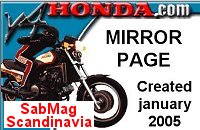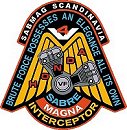|
Supercharger For
the V65 Magna |
At one time, there was a supercharger available for
the V65 Magna. The company is no longer in business,
and there are no
superchargers to be found. However, it is great to think that at one time,
you could get one for $2000 and just bolt it on!
 The whole
idea is to make motion out of fire. Somewhere along the energy-conversion path
between a hot foot and a rocket to Mars lie the engines that make motorcycles
go. Two-stroke, four-stroke or Wankel, all current bike engines share basic
features designed with the intent to convert tire into motion. All engines are
cyclical: they burn chunks of fuel-air mixture one at a time instead of
continuously as a jet or rocket engine. How much power an engine makes, all else
being equal, depends on the size of each mixture chunk and how many of them the
engine can burn in a given time period.
The whole
idea is to make motion out of fire. Somewhere along the energy-conversion path
between a hot foot and a rocket to Mars lie the engines that make motorcycles
go. Two-stroke, four-stroke or Wankel, all current bike engines share basic
features designed with the intent to convert tire into motion. All engines are
cyclical: they burn chunks of fuel-air mixture one at a time instead of
continuously as a jet or rocket engine. How much power an engine makes, all else
being equal, depends on the size of each mixture chunk and how many of them the
engine can burn in a given time period.
The more you coax into an engine during
each cycle, the more power it produces. The main thrust of conventional engine
hop-ups is to get more mixture in-to the cylinders during each intake cycle.
Fuel-air mixture finds its way into a normally aspirated engine because of a
difference in air pressure between the outside and inside of the engine. Without
sophisticated (and touchy) tuning tricks this difference cannot be greater than
14.7 psi. Millions of dollars (and hours) have been spent earning how to get the
most mixture into an engine, using this pressure difference as a basis.
Sometimes the results of such labor on normally aspirated engines can be
startling. However, supercharging-force-feeding air into the engine with a
compressor- is a more effective method of getting a lot of mixture into it.
Honda, Kawasaki, Suzuki and Yamaha have all built supercharged motorcycles, and
they have all been marketing failures.  They
used turbochargers which have an unacceptable delay between the moment the
throttle is opened and the moment the engine is actually pressurized. It takes
time for the turbocharger to spin up and deliver air at a higher rate than the
engine would normally get without the turbo.
They
used turbochargers which have an unacceptable delay between the moment the
throttle is opened and the moment the engine is actually pressurized. It takes
time for the turbocharger to spin up and deliver air at a higher rate than the
engine would normally get without the turbo.
While such a delay may be
acceptable in a car, it usually is not with a motorcycle. When power and rapid
engine response are equally important, turbos take a back seat to mechanically
driven superchargers You won't find a turbocharged top-fuel dragster, and poor
response is the reason. Mechanically driven superchargers, Iike the Jerry
Magnuson Roots-type used by CC Products, are linked directly to the engine
crankshaft by chain, belt or gear: they deliver air to the engine at a fixed
ratio controlled by engine rpm and throttle opening. Many believe a mechanically
blown engine is always pressurized. However, like a turbocharged engine, a blown
engine is pressurized only when the throttle is opened far enough. Since a
Hoots-type supercharger is already spinning at the correct rpm when the throttle
is opened, the only delay in power delivery is due to the time it takes to
pressurize the blower and intake ports.
A couple of years ago, we had the
opportunity to try CC Products' supercharger kit for the Honda GL1100. It was a
fascinating experience. The blown engine's response was as quick as the
carbureted version's. That particular bike had the blower pressure adjusted to 6
psi, so the absolute pressure available to fill the cylinders was 20.7 psi
instead of the normal 14.7. With that extra pressure, cylinder filling was much
better than stock and the CL's power was enormous.
The engine was also smoother,
if you can imagine a Gold Wing getting smoother. Suddenly the fine stock brakes
felt wimpy; we turned them blue in less than half an hour of riding. That GL1100
was a fun bike to ride, and I suggest the CC Products kit for anyone who would
like to take on super-bikes while pulling a trailer. While few GL owners are
interested in more power than they already have, superbike riders never have
enough.
With this principle firmly in mind, CC Products  mounted
one of Jerry Magnuson's motor-cycle blowers on top of the awesome Honda V65
Magna. We were given the chance to inspect and ride the beast when we were in
the San Jose area, where CC Products makes its home. Its very tall top gear
minimized the impact of the blower on the Magna's performance in Motorcyclist's
200-yard, 50-mph roll-on test.
mounted
one of Jerry Magnuson's motor-cycle blowers on top of the awesome Honda V65
Magna. We were given the chance to inspect and ride the beast when we were in
the San Jose area, where CC Products makes its home. Its very tall top gear
minimized the impact of the blower on the Magna's performance in Motorcyclist's
200-yard, 50-mph roll-on test.
Just as the Magna was entering the timing lights
in top gear, the cams, pipes and blower were beginning to work together, and it
was really beginning to sing. The top-gear roll-on speed was just 62 mph, up
from 81.5 stock. When Jeff Yarr dropped the engine into fifth gear, however, the
Magna wailed through the lights at 98 mph-an amazing 12 mph over stock. The
beauty of the CC Products blower conversion is that there is no unusual stress
on the engine when the throttle is used normally. There are no radical cams and
springs to wear rapidly, no matter how you ride.
Added engine stress occurs only
when you have the throttle against the stop. CC's kit is also cheaper than an
extensive hop-up effort (which it would probably beat). For about $2000 you can
spend a day bolting the kit onto your otherwise stock V65 - no~ tear-down, no
outside machine work and no permanent engine modifications. Just bolt it on and
go! You have no throttle delay and no ball-of-snakes exhaust plumbing.
Supercharged engines can work very well, and CC Products is proving it
So if you
have a Cold Wing or V65 or some other contemporary "slug" and would like to pump
it up, contact CC Products, 4431 Winchester Blvd., Los Gatos, CA 96030.
(408)866-6597. (THIS IS HISTORY)

